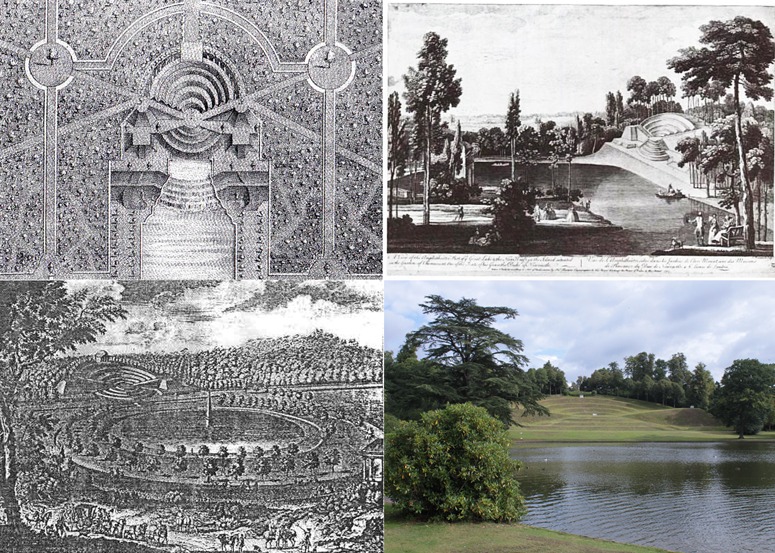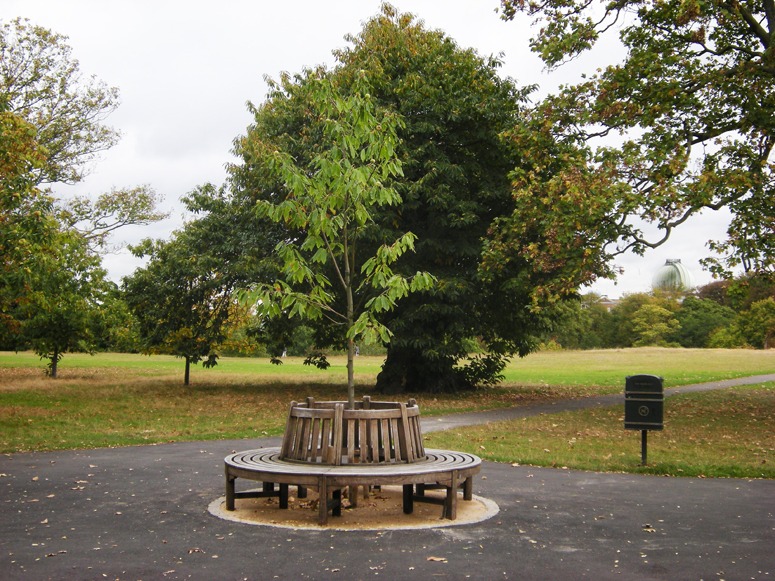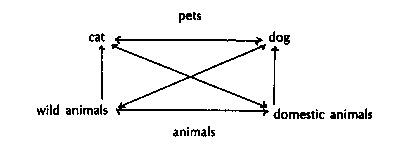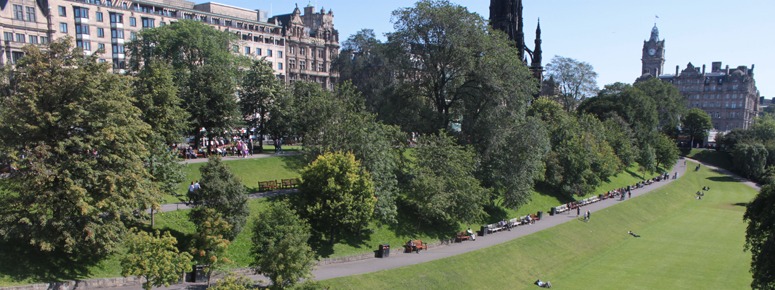
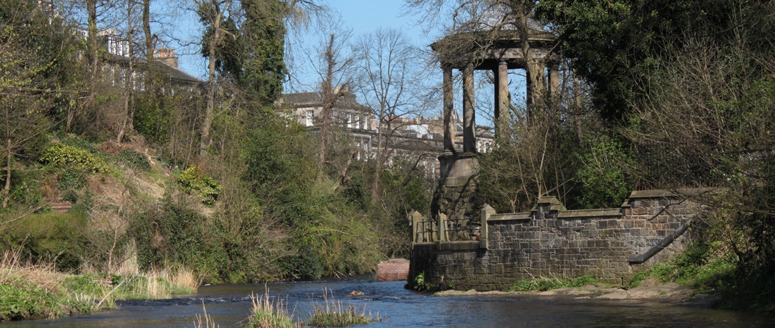 Following upon the discussion of Copenhagen’s Greenfinger Plan, here are two photographs of my hometown. They show examples of ‘urban landscapes’. BUT BUT BUT I do not regard the buildings as ‘urban’ bits and the green bits as ‘landscape’. I regard the scenic composition of buildings+landform+vegetation+paving+water (ie the Five Compositional Elements) as urban landscape compositions. Another reason for calling these examples Urban Landscapes is that they are beautiful. The below photograph of part of what was once of the most important early baroque-influenced gardens in England (Sayes Court, in Deptford) now lacks beauty and I would rather call it an ‘urban wasteland’ than an ‘urban landscape’. Sayes Court was nearly the first place to be saved from demolition by the National Trust. Things didn’t quite work out! Should any elements of the historic design be restored when Convoy’s Wharf is re-developed? The current design looks a bit Dubai-on-Thames but with duller architecture. The developers are Hutchinson Whampoa and the architects are bptw working with Aedas Architecture.
Following upon the discussion of Copenhagen’s Greenfinger Plan, here are two photographs of my hometown. They show examples of ‘urban landscapes’. BUT BUT BUT I do not regard the buildings as ‘urban’ bits and the green bits as ‘landscape’. I regard the scenic composition of buildings+landform+vegetation+paving+water (ie the Five Compositional Elements) as urban landscape compositions. Another reason for calling these examples Urban Landscapes is that they are beautiful. The below photograph of part of what was once of the most important early baroque-influenced gardens in England (Sayes Court, in Deptford) now lacks beauty and I would rather call it an ‘urban wasteland’ than an ‘urban landscape’. Sayes Court was nearly the first place to be saved from demolition by the National Trust. Things didn’t quite work out! Should any elements of the historic design be restored when Convoy’s Wharf is re-developed? The current design looks a bit Dubai-on-Thames but with duller architecture. The developers are Hutchinson Whampoa and the architects are bptw working with Aedas Architecture.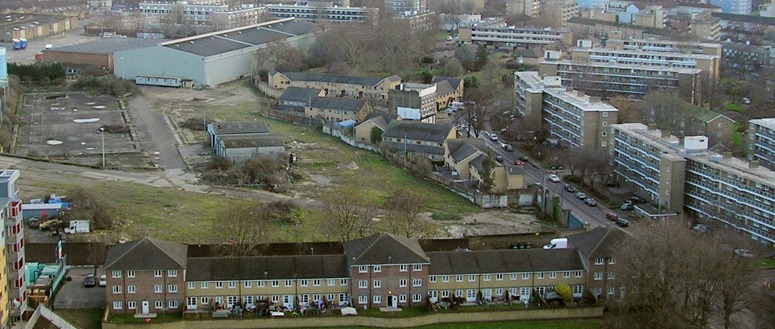
Category Archives: Historic garden restoration
The Claremont Amphitheatre as a problem in historic garden restoration
Clockwise, the images of the Claremont Amphitheatre show (1) Charles Bridgeman’s design, as illustrated in Stephen Switzer’s Hydrostatiks (2) John Rocque’s drawing shows the garden as modified by William Kent after 1734 (3) a drawing by an unknown artist with the water as a circular pool (4) a recent photo of the amphitheatre as a feature in what is now called Claremont Landscape Garden. Claremont is a pleasant and popular place – so why not leave it as it is? The amphitheatre was almost lost at one point and then restored by the National Trust. I am sure they were right to restore the amphitheatre but I do not think they went far enough. Stephen Switzer (in his Introduction to a general system of hydrostaticks and hydraulicks 1729) wrote that: ‘The upper part of the work may very easily be seen to be a sketch of the fine Amphitheatre at Claremont, (belonging to his Grace the Duke of Newcastle) the design of the very ingenious Mr. [Charles] Bridgeman; and the lower part, where the water spouts out, is an addition of my own, from a work of that kind that I have done for the Right Honourable the Earl of Orrery , at Marson in Somersetshire. In this composition, which I humbly conceive to be the noblest of any in Europe, may be seen a very magnificent taste and way of thinking, and in which I can’t help observing, that had the ingenious designer had more room at Claremont, he would certainly have made his water much larger than that little circular basin, which is seen therein, and which is very much eclipsed by the prodgious grandeur of that Amphitheatre. And this I note for the advantage of those who have more room for such a purpose: as for the rest the plan speaks for itself.’
Bridgeman and Switzer and are significant figures in the history of garden design and far too little of their work survives. More of Kent’s work survives. The problem with Claremont is that it lacks the high quality one would expect from such a distinguished cast, though Vanbrugh’s avenue, bowling green and Belvedere Tower are very good. My suggestion is to restore more of the design shown on Switzer’s drawing. I would like to see Switzer’s ‘water spouts’ and the first metre of the baroque canal (it could be done with jetties if there is insufficient land). Restoration of the ‘wilderness’ in which it is set would also be welcome (ie the woodland with straight rides and twisting paths). This would give Claremont a clear separation between (1) the Kentian landscape garden (2) the late baroque features designed by John Vanbrugh, Switzer and Bridgeman. If some way of arranging it could be found, a way of viewing the house and setting which Lancelot Brown designed for Lord Clive would also be highly desireable. The aim should be to make Claremont into first class garden it should be: it is in danger of becoming a public park for the middle classes.
A new-to-become ancient tree was planted in Greenwich Park in 2011
A landscape memorial to Saddam Hussein's "Victory" over the Marsh Arabs who lived in the Garden of Eden
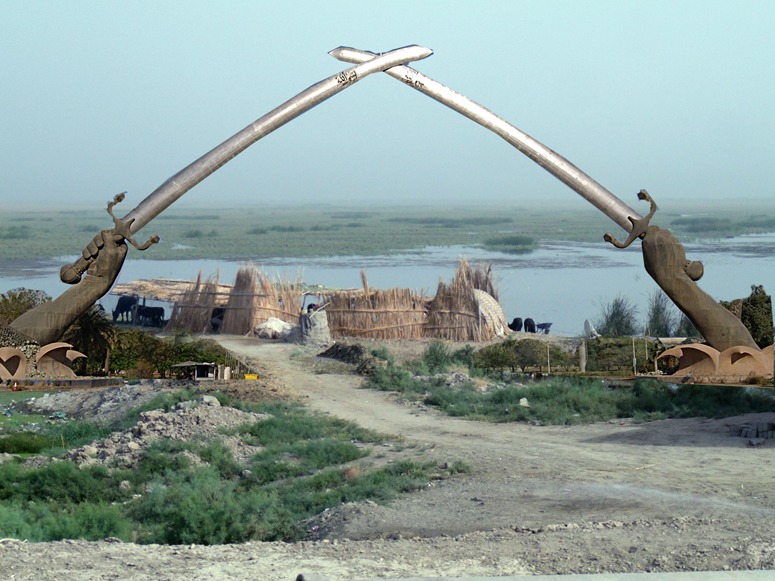
Saddam Hussein’s Victory Arch in Baghdad is being restored – with mixed feelings among commentators. Meanwhile, the habitat of the Marsh Arabs is also being restored. But the Marshes, which are often identified as the geographical location of the Garden of Eden story, now have only a few thousand inhabitants instead of the half-million who lived there before the wicked Saddam Hussein drained the marshes. My proposal is to make an area of marshland around the Victory Arch in Baghdad to symbolise the victory of the wetlands over the dictator. It could also create a tourist attraction, a wildlife resort, a water management facility and a recreation area for the oppressed people of Baghdad. The name of the city could mean Bag “god” + dād “given”, translating to “God-given” or “God’s gift”. Or it could mean Bağ “garden” + dād “fair”, translating to “The fair Garden”.
Images courtesy pennstatelive james_gordon_los_angeles
Could Hemel Hempsted's Jellicoe Water Gardens be managed by volunteers?
We observed that Hemel Hempstead Water Gardens are a National Disgrace and that Hemel Hempstead Water Gardens are getting worse and worse and worse. This led to a number of people making contact to say ‘If someone started a Friends of the Water Gardens organisation then I would help’. This, I believe, is the best way forward. As our Prime Minister would say ‘It is a Big Society initiative which would cost Dacorum Borough Council little and make the standard of care much higher’. Jane Austen, however, would have said that ‘It is a truth universally acknowledged, that two old ladies with good skills can manage a garden better than a dozen youths in sweatshirts’. I would caution her against sexism but confirm that good gardens need brains more than they need brawn. A gardener has to know what to do, how to do it, when to do it, where to do it and why it is being done.
Britain is a nation of gardeners to a much greater extent than it is a nation of shopkeepers – and to a much greater extent than America. But UK public parks make hardly any use of volunteers. The UK National Trust, in comparison, makes extensive use of volunteer gardeners and in the USA it the normal way of managing public gardens and parks. New York City Department of Parks and Recreation, for example has a page for volunteering. So do US gardens open to the public, like Longwood and so do US botanical gardens like Missouri.
My suggestion to Dacorum Borough Council (DBC) is to provide an elegant little building with a verandah where volunteers can keep their tools, wash their hands, make tea, distribute seeds and keep an eye on the gardens. You can see how this would work at Phoenix Garden in London. It is an approach which would soon make the Hemel Hempsted Water Gardens a beautiful place and a social amenity. Old folks would go there to meet their friends and get healthy exercise. The Council might find its social services bill falling as fast as its parks maintenance bill. The lager drinkers one sometimes sees in the Water Gardens might change to a life of tea drinking and hard work. Younger volunteers might find that the skills learned from older gardeners leading to skilled employment. So come on DBC: why not make everyone happier and reduce the Council budget? Isn’t that your job?
The future is blossoming
The stained glass windows of Josef Albers (1920-33) demonstrate the remarkable advances that were made in glass art in the period between 1885 (with the Tiffany glass Company) and 1933 (with students from the Bauhaus), and the increasing links between emerging art movements and gardens (hinted at by Filoli ).
Art Nouveau began a remarkable period in the history of art, when designers inspired by nature and natural forms, began a creative transformation which would lead to the pure abstraction of Modernism, perhaps most typified in the work of Gustav Klimt.
Louis Comfort Tiffany, was the third generation of successful American entrepreneurs. His father founded the jewelry company, Tiffany & Co, while his grandfather had been a leading cloth manufacturer.
Mirroring the emerging emancipation of women which typifies the age, the daffodil lamp, designed by one the ‘Tiffany Girls’ Clara Discoll, is considered among the most famous of the studio’s designs.

